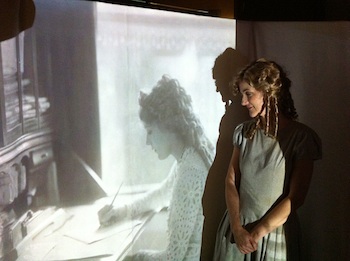by Ryan Kerr
Sweetheart was performed in historic Spadina House, which is right across from Toronto’s famous Casa Loma, produced by Lunabridge Productions.
Walking towards the illuminated venue from the subway station rivaled the excitement of approaching a dazzling marquee. And while my date and I pride ourselves on being nerdy local history buffs, once inside any visitor would find the lavish decoration of Spadina House intoxicating.
Sweetheart was performed in the main drawing room, with Sherry Squires on the grand piano and in front of a curved white sheet, used as a projection screen.
Toronto-born Mary Pickford was the biggest name in movies of the 20th Century. She co-founded a little studio called United Artists with Douglas Fairbanks and Charlie Chaplin after bravely touring the Broadway circuit from a very young age.
She also helped create this annual awards show, (what’s it called again?) oh yeah – the OSCARS – as one of the original members of the Academy of Motion Pictures Sciences.
In addition to scores of fabulous other details, the Wikipedia article calls her “one of the Canadian pioneers in early Hollywood” And frankly, if Wikipedia says it, it must be true!
When “flickers” started recording sound, however, Mary’s shrill speaking voice plummeted her from celestial being to paramount has-been. According to legend, she became famously alcoholic and died alone and in squalor.
There’s a great story in there – one full of opportunity, hope, struggle and eventual Britney Spears-style descent into madness. But somehow, creator Dean Burry managed to skip the juiciest parts of this plum story and focus instead on what made Pickford just like everybody else.
Actress Denise Norman entered through the audience and dressed in front of us, gingerly fondling artifacts and donning articles of clothing from the museum’s display. With her curly wig in place, Ms. Norman assumed the character of young Mary as she pleaded with her mother to be allowed into a local theatrical production.
While the exchange was lovingly acted, Ms. Norman played the role of both protective mother and persistent child. Unlike typical one-actor shows where the majority of the action is addressing the audience or in a self-reflective soliloquy, almost every scene in Sweetheart involved two or more characters.
It wasn’t long before Ms. Norman was actively engaging with herself as mother, father, sister, flower vendor, Broadway Starlet, boss, colleague, boyfriend, husband, judge. In every scene she either begged herself, hired herself, yelled at herself, married herself, divorced herself, or watched herself die.
As much as my date and I resisted, we could not help but see comedy even in some of the more tender parts.
I think it is unfair to ask one actor to carry an entire show, several hours long, despite formidable acting chops and marathon-like commitment and dedication, if they are required to talk with, sing to, even embrace dozens of parts they themselves create. It must have been exhausting!
“America’s Sweetheart” Mary Pickford greatly influenced the course of motion picture development and in many ways championed a lifestyle which was decades ahead of her time. Burry was bang on when he started adapting it for the stage. Maybe it just needs to be told in a slightly different way.
Details:
Sweetheart: The Mary Pickford Story closed February 27th after a two-week run.

